
Thebes, known to the ancient Egyptians as Waset, was an ancient Egyptian city located along the Nile about 800 kilometers (500 mi) south of the Mediterranean. Its ruins lie within the modern Egyptian city of Luxor. Thebes was the main city of the fourth Upper Egyptian nome and was the capital of Egypt for long periods during the Middle Kingdom and New Kingdom eras. It was close to Nubia and the Eastern Desert, with its valuable mineral resources and trade routes. It was a cult center and the most venerated city during many periods of ancient Egyptian history. The site of Thebes includes areas on both the eastern bank of the Nile, where the temples of Karnak and Luxor stand and where the city proper was situated; and the western bank, where a necropolis of large private and royal cemeteries and funerary complexes can be found.

Mendes, the Greek name of the ancient Egyptian city of Djedet, also known in ancient Egypt as Per-Banebdjedet and Anpet, is known today as Tell El-Ruba.
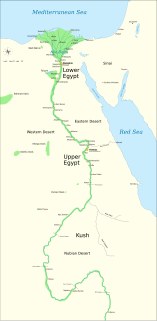
The First Intermediate Period, described as a 'dark period' in ancient Egyptian history, spanned approximately one hundred and twenty-five years, from c. 2181–2055 BC, after the end of the Old Kingdom. It comprises the Seventh, Eighth, Ninth, Tenth, and part of the Eleventh Dynasties. The concept of a "First Intermediate Period" was coined in 1926 by Egyptologists Georg Steindorff and Henri Frankfort.

The Middle Kingdom of Egypt is the period in the history of ancient Egypt following a period of political division known as the First Intermediate Period. The Middle Kingdom lasted from approximately 2050 to 1710 BC, stretching from the reunification of Egypt under the reign of Mentuhotep II in the Eleventh Dynasty to the end of the Twelfth Dynasty. The kings of the Eleventh Dynasty ruled from Thebes and the kings of the Twelfth Dynasty ruled from el-Lisht.
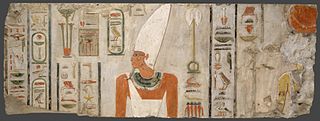
Mentuhotep II, also known under his prenomen Nephepetre, was an ancient Egyptian pharaoh circa 2061–2010 BCE, the sixth ruler of the Eleventh Dynasty. He is credited with reuniting Egypt, thus ending the turbulent First Intermediate Period and becoming the first pharaoh of the Middle Kingdom. He reigned for 51 years, according to the Turin King List. Mentuhotep II succeeded his father Intef III on the throne and was in turn succeeded by his son Mentuhotep III.
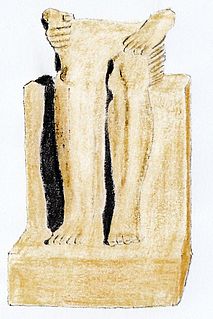
Mentuhotep I may have been a Theban nomarch and independent ruler of Upper Egypt during the early First Intermediate Period. Alternatively, Mentuhotep I may be a fictional figure created during the later Eleventh dynasty, which rose to prominence under Intef II and Mentuhotep II, playing the role of a founding father.

Sehertawy Intef I was a local nomarch at Thebes during the early First Intermediate Period and the first member of the 11th Dynasty to lay claim to a Horus name. Intef reigned from 4 to 16 years c. 2120 BC or c. 2070 BC during which time he probably waged war with his northern neighbor, the Coptite nomarch Tjauti. Intef was buried in a saff tomb at El-Tarif, known today as Saff el-Dawaba.

Wahankh Intef II was the third ruler of the Eleventh Dynasty of Egypt during the First Intermediate Period. He reigned for almost fifty years from 2112 BC to 2063 BC. His capital was located at Thebes. In his time, Egypt was split between several local dynasties. He was buried in a saff tomb at El-Tarif.
Intef III was the third pharaoh of the Eleventh Dynasty of Egypt during the late First Intermediate Period in the 21st century BC, at a time when Egypt was divided in two kingdoms. The son of his predecessor Intef II and father of his successor Mentuhotep II, Intef III reigned for 8 years over Upper Egypt and extended his domain North against the 10th Dynasty state, perhaps as far north as the 17th nome. He undertook some building activity on Elephantine. Intef III is buried in a large saff tomb at El-Tarif known as Saff el-Barqa.

Cats in ancient Egypt were represented in social and religious practices of ancient Egypt for more than 3,000 years. Several Ancient Egyptian deities were depicted and sculptured with cat-like heads such as Mafdet, Bastet and Sekhmet, representing justice, fertility and power. The deity Mut was also depicted as a cat and in the company of a cat.

Beni Hasan is an ancient Egyptian cemetery site. It is located approximately 20 kilometers (12 mi) to the south of modern-day Minya in the region known as Middle Egypt, the area between Asyut and Memphis.

Minya is the capital of the Minya Governorate in Upper Egypt. It is located approximately 245 km (152 mi) south of Cairo on the western bank of the Nile River, which flows north through the city. The name of the city is derived from its Ancient Egyptian name Men'at Khufu, meaning the nursing city of Khufu, linking it to the Pharaoh Khufu or Cheops, builder of the Great Pyramid at Giza.

Meir is a village in Upper Egypt. It is located on the west bank of the Nile, in the Asyut Governorate, some 7 kilometers southwest of el-Qusiya (Cusae). The modern village is situated at coordinates 27°27′00″N30°45′00″E, while the necropolis is located at 27°25′00″N30°43′00″E.
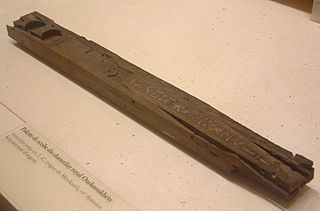
Merikare was an ancient Egyptian pharaoh of the 10th Dynasty who lived toward the end of the First Intermediate Period.
Purportedly inspired by the teaching of his father, he embarked on a semi-peaceful coexistence policy with his southern rivals of the 11th Dynasty, focusing on improving the prosperity of his realm centered on Herakleopolis instead of waging an open war with Thebes. His policy was not rewarded, and shortly after his death his kingdom was conquered by the Theban Mentuhotep II, marking the beginning of the Middle Kingdom. The existence of his pyramid has historically been ascertained, although it has not yet been discovered.
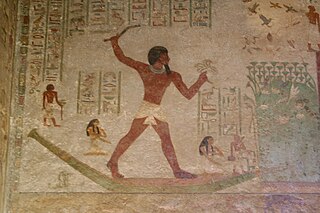
Khnumhotep II was an ancient Egyptian Great Chief of the Oryx nome during the reign of pharaohs Amenemhat II and Senusret II of the 12th Dynasty, Middle Kingdom. He is well known for his tomb at Beni Hasan and its decorations.
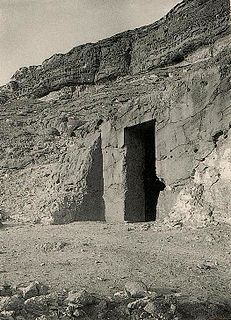
Khnumhotep I was an ancient Egyptian Great Chief of the Oryx nome during the reign of Pharaoh Amenemhat I of the 12th Dynasty, Middle Kingdom.
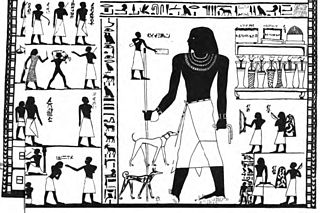
Amenemhat, often reported with his short form Ameny (Jmnjj), was an ancient Egyptian "Overlord of the Oryx nome" and chief priest during the reign of pharaoh Senusret I of the 12th Dynasty.

The Oryx nome was one of the 42 nomoi in ancient Egypt. More precisely, it was the 16th nome of Upper Egypt. It was named after the Scimitar oryx, and was roughly located in the territories surrounding the modern city of Minya in Middle Egypt.
Ramushenti was an ancient Egyptian local governor of the Oryx nome in Middle Egypt. He is only known from his decorated tomb chapel at Beni Hasan. In the decoration of his tomb chapel appear several inscriptions providing the name and titles of Ramushenti. He was great overlord of the Oryx nome. This is the main title of the local governors. Other titles include count (Haty-a), royal sealer, sole friend, king's acquaintance, who is in the chamber, who belongs to Nekhen and overlord of Nekheb,. Not much is known about his family. However, the parents of the local governor Baqet III are a person called Ramushenti and a woman called Heteperau. The two Ramushentis might be the same person. According to this, Ramushenti was the father of Baqet III who was most likely his successor.

Khety was an ancient Egyptian local governor of the Oryx nome in Middle Egypt in the Twelfth Dynasty. He is only known from his decorated tomb chapel at Beni Hasan. In the decoration of his tomb chapel appear several inscriptions providing the name and titles of Khety. He was great overlord of the entire Oryx nome. This is the main title of the local governors of the Oryx nome. Other titles include count (Haty-a), royal sealer, sole friend, king's acquaintance, who is in the chamber, who belongs to Nekhen and overlord of Nekheb, but also overseer of troops at all secret places. Not much is known about his family. His father was a person called Baqet, his wife was called Khnumhotep and there is one son attested with the name Khety. Naguib Kanawati wonders whether Khety was the son of Baqet III. The latter's tomb and those of Khety share the same plan and are close to each other.


















